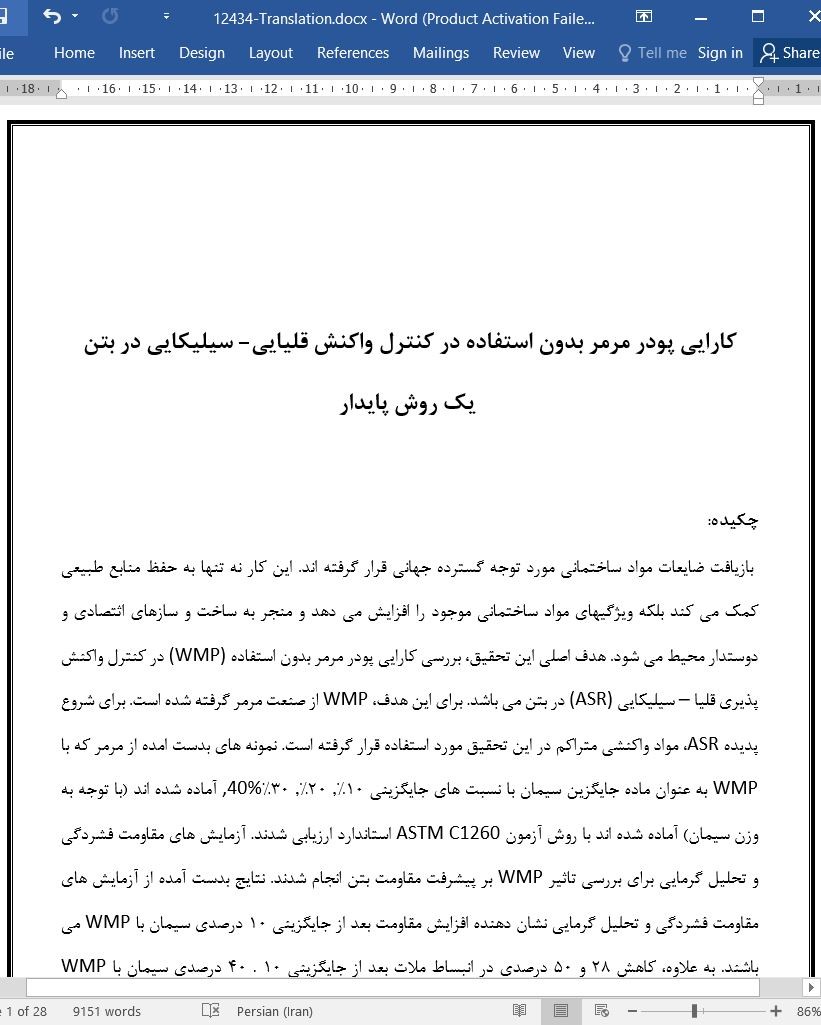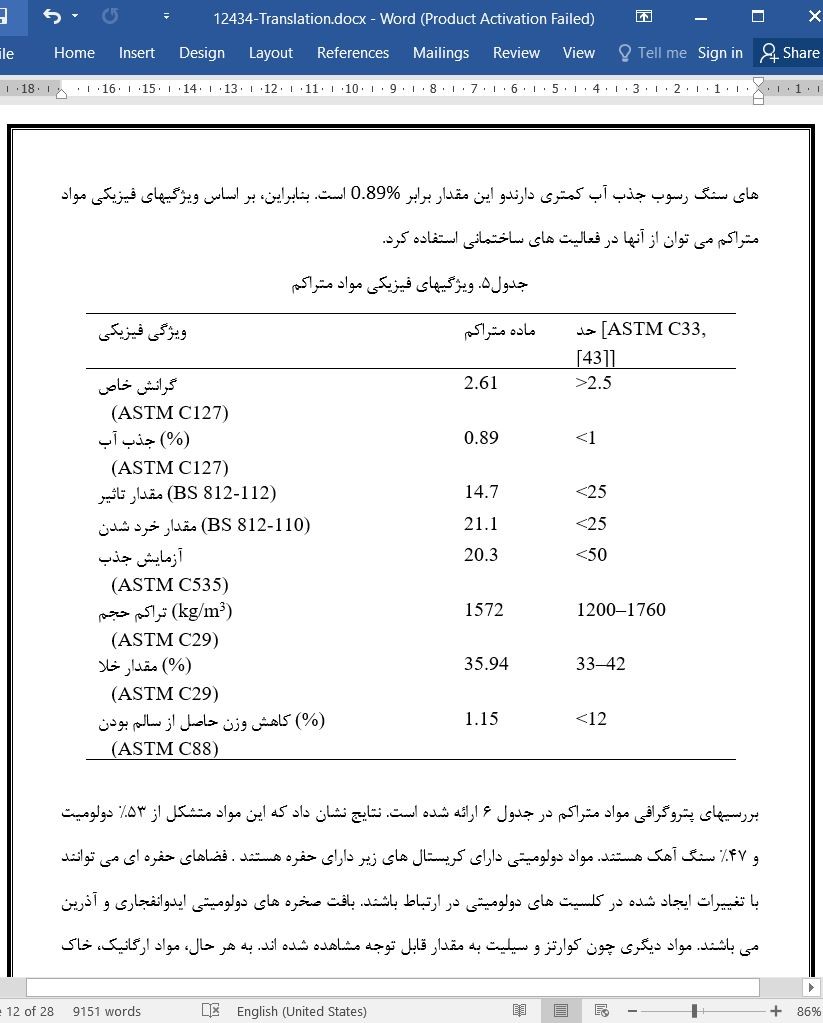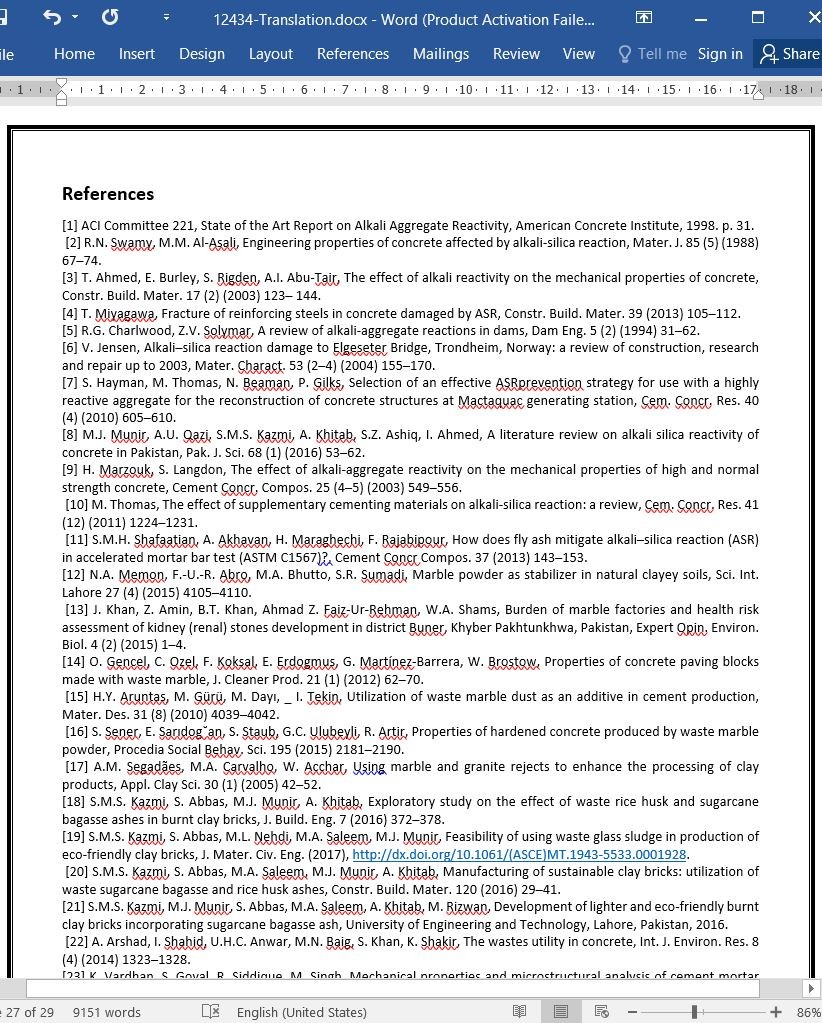
دانلود مقاله کارایی پودر مرمر بدون استفاده در کنترل واکنش قلیایی- سیلیکایی در بتن
چکیده
بازیافت ضایعات مواد ساختمانی مورد توجه گسترده جهانی قرار گرفته اند. این کار نه تنها به حفظ منابع طبیعی کمک می کند بلکه ویژگیهای مواد ساختمانی موجود را افزایش می دهد و منجر به ساخت و سازهای اثتصادی و دوستدار محیط می شود. هدف اصلی این تحقیق، بررسی کارایی پودر مرمر بدون استفاده (WMP) در کنترل واکنش پذیری قلیا – سیلیکایی (ASR) در بتن می باشد. برای این هدف، WMP از صنعت مرمر گرفته شده است. برای شروع پدیده ASR، مواد واکنشی متراکم در این تحقیق مورد استفاده قرار گرفته است. نمونه های بدست امده از مرمر که با WMP به عنوان ماده جایگزین سیمان با نسبت های جایگزینی 10%, 20%, 30%,40% آماده شده اند (با توجه به وزن سیمان) آماده شده اند با روش آزمون ASTM C1260 استاندارد ارزیابی شدند. آزمایش های مقاومت فشردگی و تحلیل گرمایی برای بررسی تاثیر WMP بر پیشرفت مقاومت بتن انجام شدند. نتایج بدست آمده از آزمایش های مقاومت فشردگی و تحلیل گرمایی نشان دهنده افزایش مقاومت بعد از جایگزینی 10 درصدی سیمان با WMP می باشند. به علاوه، کاهش 28 و 50 درصدی در انبساط ملات بعد از جایگزینی 10 . 40 درصدی سیمان با WMP مشاهده شده است.تصاویر بدست آمده از اسکن الکترو میکروسکوپی، علامتی از شکاف ASR را برای ملات دارای WMP نشان ندادند. به هر حال، وجود شکاف ناشی از ASR در نمونه های کنترل مشاهده شده است. به هر حال، طیف سنجی اشعه ایکس (EDS) نشان می دهد که مقدار قلیا بعد از جایگزینی سیمان با WMP کاهش می یابد و این عامل منجر به غلبه بر انبساط ASR می شود. بنابراین، بر اساس نتایج می توان از WMP به صورت موثر برای کنترل انبساط ASR استفاده شود و منجر به ایجاد ساختار مقاوم و اقتصادی می شود.
1. مقدمه
مسئله واکنش قلیایی – سیلیکایی (ASR) در بتن یک پدیده رایج در سراسر جهان است. مواد قلیایی (مرتبط با سیمان) باعث آزاد سازی یون های هیدروکسیل در بتن می شود. یون های هیدروکسیل تمایل دارند تا با سیلیکاییی مواد واکنشی تعامل برقرار کنند. مقدار یون های هیدروکسیل در نتیجه وجود مقدار بیشتر قلیا افزایش می یابند و این عامل منجر به واکنش سریع می شود (1). این واکنش باعث شکل گیری ژل ASR می شود که رطوبت / آب را جذب می کند و پخش می شود. ژل ASR می تواند باعث ایجاد شکاف های جزئی و متعاقبا اختلال سازه ای شود. این فرآیند یک فرآیند زمانبر است و منجر به خسارت در سازه های بتنی می شود.
ASR عاملی کشنده برای بتن در نظر گرفته می شود و از آن با عنوان " سرطان بتن یاد می شود (2). فاکتورهای مختلفی چون مواد متراکم واکنشی، مقدار مواد قلیایی و رطوبت موجود نقش مهمی در پخش ASR در بتن ایفا می کنند. ویژگیهای مکانیکی و همچنین ویژگیهای مقاومتی تا حد زیادی تحت تاثیر وجود ASR در بتن قرار می گیرند (3.4).مطالعات موردی مختلف در مورد ASR در سازه ها موجود است (5). مسئله ASR در سازه های مختلفی چون تاسیسات هیدروالکتریک در آتلانیک کانادا، پل الگستر نروژ، سد وارساک و تاربلا در پاکستان (8-6) مورد بررسی قرار گرفته است. مقاومت کششی همراه با قدر مطلق ارتجاعی از ویژگیهای بتن هستند که تحت تاثیر ASR قرار می گیرند (3.9).
5. نتیجه گیری ها
بازیافت WMP در بتن نه تنها باعث افزایش مقاومت مواد ساختمانی می شود، بلکه تاثیرات منفی محیطی را نیز کاهش می دهد. بر اساس نتایج بدست آمده، می توان نتیجه گیری های زیر را بیان کرد:
1. WMP نه یک ماده پوزولانی است و نه ماده ای کاملا خنثی. کارایی کمتر برای ترکیبات دارای WMP مشاهده شده است. خمیر ملات بدون WMP جریان 110 mm را نشان می دهد، در حالی که جریان 101 mm برای آن دسته از خمیرهایی مشاهده می شود که دارای 40%WMP هستند. همچنین، نسبت w/c بعد از جایگزینی سیمان دارای 40% WMP از 0.47 به 0.53 افزایش می یابد و به حریان ثابت 110 mm می رسد.
2. نتایج مقاومت فشردگی نشان داد که افزایش مقاومت برای نمونه های دارای 10% WMP در 28 و 56 روز مشاهده می شود. به هر حال، مقدار بیشتر WMP(برای نمونه، 20%, 30% ,40%) نشان دهنده کاهش در مقاومت مواد در مقایسه با نمونه های کنترل هستند. مقاومت در نمونه های گروه کنترل در 28 روز برابر 48.9 MPa و در 56 روز برابر 53.1 MPa مشاهده شده است. در حالی که مکعب های ملات دارای 10% WMP در 28 روز مقاومت 49.4 MPa و در 56 روز 53.2 MPa را نشان داده اند. بنابراین، بر اساس نتایج می توان بیان کرد که 10% WMP می تواند به طور موثر در جایگزینی سیمان مورد استفاده قرار بگیرد.
3. انبساط میله ای ملات بعد از جایگزینی سیمان با WMP اتفاق می افتد. بیشترین کاهش در انبساط میله ای سیمان (برای نمونه، کاهش 50 درصدی) بعد از جایگزینی 40 درصدی سیمان با WMP مشاهده می شود و این عامل منجر به غلبه بر فشارهای ASR می شود.
4. بررسی های میکروسکوپی از نمونه های کنترل نشان دهنده وجود شکاف حاصل از ASR است. به هر حال، در نمونه های دارای WMP علامتی از شکاف ASR مشاهده نمی شود. مقدار قلیا نیز بعد از جایگزینی سیمان با WMP کاهش می یابد و منجر به کاهش انبساط ASR می شود.
بنابراین، WMP می تواند به صورت موثر برای کنترل انبساطASR و غلبه بر مسائل محیطی منجر به ساختارهای پایدار و اقتصادی استفاده شود.
Abstract
Recycling of wastes in building materials is gaining a lot of attention worldwide. This not only conserves natural resources but also enhances the properties of existing building materials leading to economical and environment friendly construction. The main aim of this study was to explore the efficiency of waste marble powder (WMP) in controlling alkali silica reactivity (ASR) of concrete. For this purpose, WMP was obtained from a marble industry. To initiate the ASR phenomena, reactive aggregate was used in the study. Mortar bar specimens prepared with WMP as cement replacement material at 10%, 20%, 30% and 40% replacement levels (by cement weight) were evaluated in the standard ASTM C1260 test method. Compressive strength and thermal analysis tests were performed to investigate the effect of WMP on strength development of concrete. Results of compressive strength and thermal analysis showed improved strength after 10% of cement replacement with WMP. Moreover, 28% and 50% reduction in mortar bar expansion was observed after replacing 10% and 40% of cement with WMP, respectively. Scanning electron microscopic images also showed no signs of ASR cracking for mortar bars incorporating WMP. However, presence of cracks due to ASR was observed in control specimens. Furthermore, energy disperse X-ray spectroscopy (EDS) showed that amount of alkalies reduced after replacing cement with WMP, leading to overcome ASR expansion. Therefore, based on the results WMP can be effectively used to control ASR expansion leading to durable, sustainable and economical construction.
1. Introduction
Problem of alkali silica reaction (ASR) in concrete is common around the world. Alkalies (mainly due to cement) release hydroxyl ions in concrete. Hydroxyl ions have the tendency to react with silica of reactive siliceous aggregates. Amount of hydroxyl ions increases as a result of higher alkalies leading to rapid reaction [1]. This reaction results into the formation of ASR gel, which absorbs moisture/water and expands. ASR gel can cause minor cracking leading to major structural distress. It is a time taking process and results into damage of concrete structures.
ASR is considered deadly for concrete and referred as ‘‘cancer of concrete” [2]. Different factors like, reactive aggregates, alkali content and available moisture play an important role in ASR propagation in concrete. Mechanical properties as well as durability properties are greatly affected as a result of ASR in concrete [3,4]. Different case studies are available regarding ASR in structures [5]. Problem of ASR was reported in different structures such as hydroelectric plant in Atlantic Canada, Elgeseter Bridge Norway, Warsak and Tarbela dam in Pakistan [6–8]. Tensile strength along with elastic modulus are the properties of concrete, considered greatly affected by ASR [3,9].
5. Conclusions
Recycling WMP in concrete not only improves the durability of building materials but also reduces environmental burden. Based on the results, conclusions were drawn as follows.
1. WMP is neither a pozzolanic material nor a fully inert material. Reduced workability was observed for mixtures incorporating WMP. Mortar paste without WMP showed a flow of 110 mm; whereas, flow was 101 mm for mixture with 40% of WMP. Similarly, w/c ratio was increased from 0.47 to 0.53 after replacing 40% cement with WMP to achieve a constant flow of 110 mm.
2. Results of compressive strength showed increase in strength for specimens with 10% WMP at 28 and 56 days. However, higher content of WMP (i.e. 20%, 30% and 40%) showed a decrease in strength as compared to control specimens. Strength of control specimens was observed 48.9 MPa at 28 days and 53.1 MPa at 56 days; whereas mortar cubes incorporating 10% WMP showed strength of 49.4 MPa at 28 days and 53.2 MPa at 56 days. Therefore, based on the results 10% WMP can be effectively used in replacement of cement.
3. Mortar bar expansion reduced after replacing cement with WMP. Highest reduction in mortar bar expansion (i.e., 50% reduced expansion) was observed after replacing 40% cement with WMP, leading to overcome ASR distress.
4. Microscopic examination of control specimens showed the presence of cracks due to ASR. However, specimens incorporating WMP showed no signs of ASR cracking. Amount of alkalies also reduced after replacing cement with WMP, leading to reduce ASR expansion.
Therefore, WMP can be effectively used to control ASR expansion and to overcome related environmental issues leading to sustainable and economical construction.
چکیده
1. مقدمه
2. برنامه تجربی
2.1 مواد
2.2 نسبت های ترکیب
3. روشهای آزمایش
3.1 مواد خام
3.2 ویژگی های تازه بودن ملات
3.3 مقاومت فشردگی
3.4 آزمایشات حرارتی
3.5 نمونه های دارای انبساط ستونی
4. نتایج و بحث
4.1 ویژگیهای مواد
4.2 ویژگیهای تازه بودن ترکیبات ملات های دارای WMP
4.2.1 زمان تنظیم شده و استحکام
4.2.2 سالم بودن
4.2.3 کارایی
4.3 مقاومت فشردگی
4.4تحلیل حرارتی
4.5 نتایج انبساط ستون ملات
4.6 بررسی های میکروسکوپی و تحلیل EDS
5. نتیجه گیری ها
منابع
Abstract
1. Introduction
2. Experimental program
2.1. Materials
2.2. Mixture proportions
3. Test methodologies
3.1. Raw materials
3.2. Fresh properties of mortar
3.3. Compressive strength
3.4. Thermal examination
3.5. Mortar bars expansion specimens
4. Results and discussion
4.1. Material characterization
4.2. Fresh properties of mortar mixtures incorporating WMP
4.2.1. Consistency and setting time
4.2.2. Soundness
4.2.3. Workability
4.3. Compressive strength
4.4. Thermal analysis
4.5. Mortar bar expansion results
4.6. Microscopic examination and EDS analysis
5. Conclusions
References
- اصل مقاله انگلیسی با فرمت ورد (word) با قابلیت ویرایش
- ترجمه فارسی مقاله با فرمت ورد (word) با قابلیت ویرایش، بدون آرم سایت ای ترجمه
- ترجمه فارسی مقاله با فرمت pdf، بدون آرم سایت ای ترجمه



